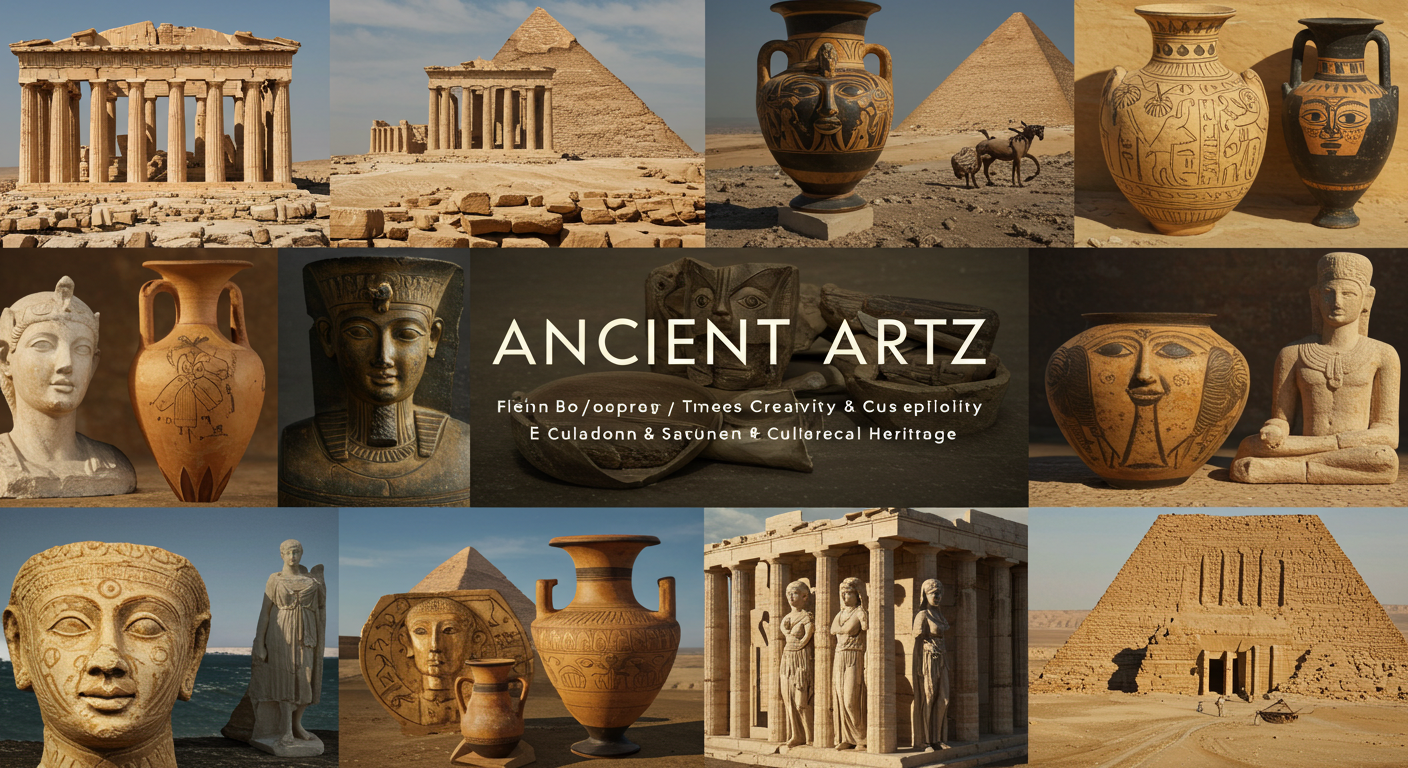Blog
Ancient Artz | Timeless Creativity & Cultural Heritage

Art has always been more than an aesthetic endeavor—it is a lens through which we understand our predecessors, their beliefs, and the world they lived in. Ancient art, in particular, holds a timeless allure, bridging the past to the present with creativity and cultural heritage that never ceases to inspire. From the intricate pottery of the ancient Egyptians to the grand temples of the Greeks and the enduring tales etched into cave walls, ancient art is a testament to the human spirit and ingenuity.
This blog explores the world of ancient art, highlighting its cultural significance, key styles, and how its timeless creativity continues to influence modern artistry. Whether you’re an art enthusiast, a history lover, or someone wanting to learn more, discover how ancient art connects us to our roots and enriches contemporary creativity.
What Makes Ancient Art Special?
Unlike modern art, which often reflects personal expression or contemporary issues, ancient art was primarily a reflection of societal values, religious beliefs, and daily life. It served purposes beyond mere decoration—it was a storytelling medium, a record of history, and a tool for religious rituals.
- Cultural Documentation
Ancient art offers a glimpse into the traditions, customs, and values of civilizations long gone. A Greek amphora, for example, tells tales of heroic warriors, while an Egyptian fresco depicts ceremonies honoring the gods. These works preserve fragments of societies that have shaped human history.
- Craftsmanship with Tools of the Time
One of the most fascinating aspects of ancient art is the exceptional craftsmanship achieved with rudimentary tools. The precision of Mayan carvings or the intricate designs of Roman mosaics remains awe-inspiring, demonstrating the artists’ ingenuity and mastery.
- Timelessness
The masterpieces of ancient art have stood the test of time—both physically and culturally. The Great Pyramids of Giza, the Parthenon in Athens, or the cave paintings of Lascaux still evoke awe and influence new generations of artists, architects, and historians.
Understanding ancient art is not just about admiring its beauty; it’s about connecting with human innovation and the stories that continue to resonate today.
Styles and Mediums of Ancient Art
Throughout history, civilizations have developed distinct artistic styles and mediums based on their resources, beliefs, and societal needs. Here’s a closer look at some prominent forms of ancient art.
1. Cave Paintings
- Time Period: Prehistoric (as early as 30,000 BCE)
- Medium: Natural pigments such as charcoal, ochre, and hematite
- Notable Examples: Lascaux Caves (France), Altamira Caves (Spain)
These works, often depicting animals and human figures, are among the earliest examples of human creativity. Many are believed to have spiritual or ritualistic significance, aiming to connect hunters with their prey or invoke divine favor.
2. Ancient Egyptian Art
- Time Period: 3100 BCE – 30 BCE
- Medium: Limestone, papyrus, gold, and paint
- Notable Examples: Wall paintings in tombs, statues of pharaohs
Marked by strict conventions, Egyptian art prioritized symmetry and proportion to convey perfection and divine order. Each detail, from the size of the figures to their movements, carried symbolic meaning.
3. Mesopotamian Reliefs
- Time Period: 3000 BCE – 538 BCE
- Medium: Stone and clay carvings
- Notable Examples: Assyrian palace reliefs
Known for their intricate engravings, Mesopotamian reliefs often depicted scenes of gods, warriors, and royal conquests, emphasizing power and divine protection.
4. Ancient Greek and Roman Sculptures
- Time Period: 800 BCE – 476 CE
- Medium: Marble, bronze
- Notable Examples: The statues of Venus de Milo and Augustus of Prima Porta
Greek and Roman artists mastered human anatomy to create life-like sculptures that conveyed emotions and movement. While Greek art often celebrated idealized beauty, Roman works emphasized realism and individual character.
5. Mesoamerican Art
- Time Period: 1500 BCE – 1521 CE
- Medium: Jade, basalt, clay
- Notable Examples: Olmec heads, Mayan glyphs, Aztec sun stones
Mesoamerican art is highly symbolic, often tied to cosmology and religious rituals. Large-scale structures like pyramids and sculptures illustrate their advanced engineering and artistic skills.
The Cultural Significance of Ancient Art
Ancient artz wasn’t created in isolation. It reflects the cultural, economic, and religious fabric of its time. Here are three key cultural impacts:
- Religious Expression
From the grand Hindu temples of India to the serene Buddha statues across Asia, ancient artworks often served religious purposes. They were visual representations of devotion, serving as conduits to the divine.
- Social Hierarchy
Art often communicated power and authority. For instance, the grandeur of the Egyptian pyramids symbolized the pharaohs’ godlike status, while the life-sized statues of Roman emperors portrayed supreme control.
- Storytelling
Before written language became widespread, art conveyed stories and lessons. The Aboriginal rock paintings in Australia, for example, document ancestral tales passed down through generations.
How Ancient Art Influences Modern Creativity
The influence of ancient artz extends far beyond history books and museum walls. Its timeless creativity serves as a foundation for modern artistic and architectural endeavors:
- Artistic Techniques
The fresco techniques perfected by Renaissance artists have roots in ancient Roman and Greek methods. Similarly, the use of proportion and balance in visual arts owes much to classical traditions.
- Symbolic Design
Themes such as heroism, divinity, and nature borrowed from ancient motifs inspire contemporary artists and designers. Many fashion collections and visual media incorporate ancient symbols and aesthetics.
- Architecture
Modern architecture often draws inspiration from structures like Roman aqueducts, Greek columns, and Egyptian obelisks. These timeless designs continue to shape skyline silhouettes.
Preserving Ancient Art for Future Generations
To appreciate ancient artz is to recognize its fragility. Many of these works are susceptible to natural decay, environmental changes, and human interference. UNESCO and other conservation groups actively work to preserve this cultural legacy, but we all share a responsibility to support such efforts.
Whether visiting a historical site or supporting digital preservation projects, your efforts contribute to making these treasures accessible to future generations. Consider exploring virtual tours or donating to organizations dedicated to safeguarding world heritage.
Your Connection to Timeless Creativity
Ancient artz is a bridge between humanity’s past and present. It reminds us where we’ve been and inspires us to imagine where we could go. By understanding and appreciating its stories, techniques, and enduring beauty, you become part of an artistic lineage that stretches across millennia.
Explore these wonders not just as artifacts but as vibrant ties to human history. Visit museums, attend exhibitions, or engage in conversations that deepen your connection to the timeless creativity of ancient art.
Unlock the inspiration waiting for you in history’s masterpieces.
Final Thoughts
Ancient artz is more than a window into history; it is a testament to human ingenuity, perseverance, and the shared desire to create meaning through beauty. By exploring these masterpieces, we connect with the aspirations, struggles, and triumphs of those who came before us. Whether through careful preservation, active engagement, or a deeper understanding of its significance, we have the power to ensure that this legacy thrives. Let ancient art remind us not only of our past but also of our potential to shape a future where creativity and culture remain deeply valued.
Conclusions
The study and appreciation of ancient art reveal remarkable insights into humanity’s shared heritage and enduring creativity. By cherishing these works, we honor the cultures that formed the foundation of modern civilization while preserving their legacy for future generations. Ancient art teaches us that the pursuit of beauty and meaning transcends time, reminding us of the timeless power of creativity to unite and inspire. It is our responsibility to continue safeguarding this cultural wealth, ensuring that its lessons and wonders remain accessible to all who seek them.
FAQs
What is ancient art?
Ancient artz refers to the creations of early civilizations, including sculptures, paintings, pottery, architecture, and other artistic expressions. These works provide insight into the beliefs, traditions, and daily lives of past societies, often functioning as both artistic endeavors and practical tools or ceremonial objects.
Why is ancient art important?
Ancient artz holds immense cultural, historical, and educational value. It connects us to the origins of human creativity, offering a window into the evolution of culture and society. By preserving and studying these works, we gain a deeper understanding of our collective past and the foundations of modern civilization.
How can we preserve ancient art?
Preserving ancient artz requires a combination of scientific techniques, responsible stewardship, and public awareness. This includes the use of advanced conservation methods, protection against environmental damage, and the enforcement of laws to prevent theft or illegal trade. Additionally, promoting awareness and funding for preservation efforts helps ensure the survival of these treasures.
Where can ancient art be viewed?
Ancient Artz can be viewed in museums, archeological sites, and online digital archives. Many renowned institutions, such as The Louvre, The British Museum, and The Metropolitan Museum of Art, house extensive collections of ancient art from across the globe, providing access to these masterpieces for scholars and the public alike.
Blog
How Reliable Oil Delivery Services Keep Homes Running Smoothly

As temperatures drop and winter approaches, the role of a trustworthy oil delivery service becomes critical for families wanting to maintain a warm, comfortable home. Dependable fuel delivery means more than just convenience—it provides homeowners with peace of mind, knowing they will never be left unexpectedly without heat. This reliability can make all the difference during harsh weather or supply shortages. Discover more about COD fuel and how a reliable provider can make heating your home stress-free.
Access to a consistent oil supply is crucial not only for comfort but also for ensuring your home’s heating system remains in excellent working condition. If a delivery is missed or delayed, it can cause more than just inconvenience—it may lead to heating problems or system breakdowns, sometimes requiring costly repairs.
Beyond comfort, the predictability and transparency that come with dependable oil delivery services can simplify budgeting and daily routines. Whether you’re seeking automatic delivery or prefer to monitor your own needs, choosing a reputable provider should be part of every homeowner’s winter preparation plan.
To take a deeper look at the importance of reliable oil delivery, resourceful options for delivery schedules, and advances in the industry, continue reading for practical advice and expert insights. For further guidance, The New York Times’ review of heating fuels can be a valuable resource for understanding the available options.

Importance of Reliable Oil Delivery
Having a steady supply of heating oil is essential during the coldest months of the year. Interruptions or unexpected run-outs can cause disruption, discomfort, and even safety risks for families—especially during winter storms or extreme temperatures. Reliable oil delivery providers plan, monitor usage patterns, and anticipate peak periods to ensure their customers are always supplied with the fuel they need.
Additionally, dependable delivery supports the longevity and efficiency of your heating system. Frequent or severe shortages can introduce air into the system, potentially leading to malfunctions or damage. A reputable service keeps these risks at bay, ensuring your equipment functions properly and reducing the need for emergency repairs.
Automatic vs. Will-Call Delivery
When arranging for home heating oil, homeowners generally choose between two types of delivery schedules:
- Automatic Delivery: With this service, the provider tracks your fuel usage and weather patterns to schedule deliveries automatically. This eliminates the need for monitoring tank levels, ensuring you won’t run out during critical times. It’s a set-it-and-forget-it solution, ideal for busy families.
- Will-Call Delivery: This method gives you control—you monitor your own oil levels and contact the provider when you need more fuel. While this offers flexibility and may suit those who use their heating system sporadically, it also demands attention and careful planning, especially in colder months.
If you’re undecided about which option works for you, reading up on how automatic delivery compares to will-call services from trusted publications can be a great starting point.
Technological Advancements in Delivery Services
Modern oil delivery services utilize innovative technology to enhance both accuracy and reliability. Smart tank monitors provide real-time updates on fuel levels, eliminating the guesswork and enabling providers to forecast demand and schedule timely deliveries. These technologies help reduce the risk of unexpected shutdowns and enable precise, efficient refueling—even during high-demand periods.
Additionally, route optimization and GPS navigation enable drivers to deliver oil more quickly and efficiently, regardless of changing road or weather conditions. These advancements not only enhance customer satisfaction but also facilitate more effective fuel resource management and contribute to the provider’s overall reliability.
Choosing the Right Oil Delivery Service
Selecting a reputable provider is crucial for ensuring your home remains warm throughout the winter. It’s important to consider:
- Reliability and Reputation: Look for reviews and testimonials highlighting the provider’s consistency and promptness.
- Transparent Pricing: Avoid providers with hidden fees by asking for clear explanations of their rates and policies.
- Customer Support: Access to knowledgeable, responsive staff can be critical if you ever face emergencies or require last-minute adjustments to your delivery schedule.
Consulting consumer resources is a helpful way to evaluate potential businesses before making a decision.
Preparing Your Home for Safe Delivery
To facilitate a safe and seamless delivery process, ensure driveways and walkways are clear of snow and ice. The path to your oil tank must also be accessible for service personnel, especially in winter conditions. Regular tank and heating system maintenance can prevent operational issues and keep your system running efficiently during refueling.
Preparation is about more than convenience—it also ensures the safety of your home, your family, and the professionals delivering your fuel.
Budgeting and Payment Plans
Many oil delivery companies offer a variety of payment and budget programs designed to reduce the financial burden of heating through the colder months. Budget plans often spread the cost of heating oil evenly over the year, making monthly payments predictable. Pre-pay plans enable homeowners to secure a fixed price before the season begins, protecting them from price spikes during peak demand.
Understanding your provider’s payment options can help you manage expenses and alleviate financial stress during winter.
Environmental Considerations
Today’s consumers have options for reducing their home heating footprint. Some oil delivery services offer blends, such as Bioheat, which combine traditional heating oil with renewable resources like biodiesel. These fuels burn cleaner, helping to lower emissions and contribute to a more sustainable home environment. If environmental sustainability is a priority for your family, ask prospective providers about their eco-friendly options.
Conclusion
Reliable oil delivery services form the backbone of a warm, efficient, and safe home in winter. By understanding what to look for in a provider, how to prepare your home, and the benefits of technological improvements and flexible payment plans, you can ensure that your heating needs are covered, no matter the weather. The right oil delivery partner will ensure your home stays comfortable, your expenses are manageable, and your winter is worry-free.
Blog
Doodflix: A Comprehensive Guide to Features, Uses, Safety and User Experience

The term doodflix has steadily gained attention among online streamers who seek easy access to entertainment, flexible viewing options, and a smooth user experience. In the first paragraph, it is important to highlight that is often associated with fast streaming, minimal disruptions, and a user-friendly layout, making it appealing to a wide audience across different regions. Because the digital entertainment landscape constantly evolves has found its place among viewers who look for convenience and variety.
This article provides a complete, human-written breakdown of doodflix—its features, benefits, risks, technical aspects, comparisons, and user opinions. The goal is to help readers understand how stands out and whether it is suitable for their online entertainment needs.
Understanding What Doodflix Represents in Online Entertainment
Meaning and Purpose of Doodflix
it represents a modern digital streaming experience where users expect easy accessibility, quick loading, and organized content. Although is not a conventional mainstream platform, many users associate it with fast streaming solutions that focus on smooth performance rather than complex subscriptions or restrictive features.
Core Features That Make Doodflix Appealing
it continues to attract attention because of its simplified interface and easy-to-navigate layout. Users appreciate:
-
Lightweight streaming
-
Minimal buffering
-
Simple design
-
Fast loading features
-
Wide content accessibility
These features create a streamlined experience, making suitable for individuals who prefer straightforward entertainment options.
Why Users Search for Doodflix Today
Doodflix as a Solution for Fast and Flexible Viewing
As streaming becomes a major form of entertainment worldwide stands out by offering speed and flexibility. It removes unnecessary complications, making the experience convenient for people who just want to click and watch without limitations.
How Doodflix Fits Into the Modern Streaming Market
The digital entertainment industry now includes countless websites, apps, and subscription-based services finds relevance by serving users who do not want recurring fees or heavy apps that consume device storage. Instead, focuses on fast loading pages, simple categories, and instant accessibility.
Doodflix Features and How They Enhance User Experience
User Interface Design of Doodflix
One defining attribute of is its user interface. It emphasizes clarity, reduced clutter, and easy navigation. Users can browse content without confusion, and the homepage usually relies on a layout that prioritizes titles and thumbnails.
Performance Benefits of Doodflix
The performance of is often described as smooth and reliable, with a core focus on minimizing buffering. This performance is especially important for viewers in areas with inconsistent internet speeds. Because is designed to load quickly, it remains popular among mobile users and individuals who want instant entertainment.
Doodflix vs Competitors: A Comparative Table
To better understand howstands among other streaming experiences, the table below provides a simplified comparison based on user expectations:
| Feature Category | Doodflix | Subscription Platforms | Free Streaming Sites |
|---|---|---|---|
| Cost | Free | Monthly Fee | Free |
| Loading Speed | Fast | Moderate | Varies |
| Interface | Simple | Advanced | Mixed |
| Accessibility | High | Restricted | High |
| Content Type | General Entertainment | Premium Exclusive | General |
This table is intended to help readers visually compare with other digital streaming options.
Modern Usage of Doodflix and User Preferences
Why Users Prefer Doodflix for Mobile Viewing
Mobile users often choose because it works well even on lower-end devices. Websites and apps that require heavy RAM can reduce the viewing experience, but is known for being lightweight and responsive. This makes it ideal for quick, on-the-go streaming.
Doodflix for International Viewers
it has also become popular among international users due to its easy accessibility. Many streaming sites restrict content by region, but often provides a more inclusive experience. As global demand for entertainment rises, remains a flexible solution for cross-border viewers.
Doodflix Safety, Legality, and User Awareness
Safety Considerations for Doodflix Users
Although is attractive for its convenience, users should remain aware of potential safety concerns. Some versions of may include pop-ups or third-party ads. It is important to use secure devices, updated browsers, and reliable internet connections to avoid possible risks.
Legality Concerns Surrounding Doodflix
Understanding the legal side of is essential. Depending on the region, certain online streaming activities may fall into a gray zone. Users should always follow their country’s digital regulations and ensure responsible online behaviour itself is not a mainstream licensed platform, and therefore users should be cautious and informed.
How Doodflix Continues to Evolve in the Digital Age
Technological Improvements in Doodflix Platforms
Over time has adapted to technological advancements by enhancing loading capabilities, reducing lag, and supporting modern devices. These improvements help maintain relevance among younger audiences who expect better performance from digital platforms.
Growing User Base and Digital Trends
Doodflix continues to attract new viewers because modern streaming demands align with what offers—quick access, broad availability, and straightforward design. As digital trends push for faster and more efficient entertainment platforms remains a competitive option for casual viewers.
Tips for Improving User Experience on Doodflix
Optimizing Devices for Better Doodflix Performance
To enjoy fully, users can take several steps:
-
Use updated browsers
-
Clear cache regularly
-
Avoid running unnecessary background apps
-
Enable stable internet connections
These small adjustments can improve loading speed and enhance the overall experience.
How Viewers Can Navigate Doodflix More Effectively
Doodflix is simple by design, but users can organize their viewing habits by bookmarking pages, saving categories, and managing browsing history. These practices help viewers return to content without searching repeatedly.
The Future of Doodflix in Online Streaming
Doodflix represents a different side of digital entertainment—one focused on speed, simplicity, and open accessibility. While it does not operate like traditional premium platforms, its strengths lie in adaptability and user-focused convenience. As viewers prioritize fast and flexible experiences continues to appeal to a wide range of digital audiences.
The future of will depend on continued innovation, user safety, and evolving preferences in the streaming world. If embraces enhanced security features and improved design, it may remain a go-to option for quick, easy entertainment for years to come.
Blog
Zuschneidfelle: A Complete Guide to Understanding the Concept and Its Modern Uses

The term zuschneidfelle has become increasingly recognized in the world of crafting, tailoring, and precision work because it represents a durable and reliable material used for accurate cutting performance. In the first paragraph of this article, it is important to highlight that are not just basic accessories—rather, they are functional surfaces designed to support craftsmen, designers, and artisans who demand stability and precision. As more creators seek tools that enhance both efficiency and safety have become essential in the workshop, home studio, and professional environment.
This article explores what makes unique, how they are used, the materials involved in their construction, and what factors to consider when choosing one. You will also find a comparison table, usage insights, and maintenance tips to ensure longevity.
Understanding Zuschneidfelle and Why They Matter
What Zuschneidfelle Represent in Modern Crafting
it are cutting surfaces made from specially designed materials that protect tools, enhance precision, and provide a consistent working base. They are used in tailoring, leatherwork, pattern making, and other precision-based crafts where the quality of the surface directly affects the outcome of the work.
Key Features That Define Zuschneidfelle
Because are used by professionals and enthusiasts alike, their features must support consistency and long-term durability. These features often include:
-
Smooth cutting texture
-
High resistance to wear
-
Shock absorption
-
Tool protection
-
Non-slip surfaces
These qualities make valuable for both experienced artisans and beginners seeking accuracy.
Types of Zuschneidfelle and Their Functional Differences
Traditional Zuschneidfelle Material Options
While many cutting surfaces exist often combine traditional craftsmanship with modern engineering. Below are common materials featured in construction:
-
Natural hide-based surfaces – valued for authenticity and durability
-
Synthetic composites – known for consistency, affordability, and precision
-
Layered rubber materials – provide strong resistance and self-healing properties
Each type serves a slightly different purpose, and choosing the right depends on your craft.
Table: Comparison of Zuschneidfelle Material Types
The following table provides a simplified comparison to help buyers understand what sets each type apart:
| Material Type | Durability | Precision Level | Maintenance | Ideal Use |
|---|---|---|---|---|
| Natural Hide Zuschneidfelle | Very High | High | Moderate | Leatherwork, Tailoring |
| Synthetic Zuschneidfelle | High | Very High | Low | Pattern Cutting, Crafting |
| Rubber-Based Zuschneidfelle | Medium to High | Medium | Very Low | General Cutting Work |
This table helps highlight how different materials influence the overall crafting experience.
Zuschneidfelle in Tailoring, Sewing, and Leather Craft
How Zuschneidfelle Improve Tailoring Precision
Tailors depend on precision tools to achieve clean, symmetrical results offer a steady and reliable surface that eliminates slipping, tearing, or inaccurate cuts. When working with delicate fabrics, the stability of acts as the foundation for excellent craftsmanship.
Zuschneidfelle for Leatherworkers
Leather is thicker and more resistant than fabric, requiring a surface that supports heavy-duty cutting without dulling blades made from hide or advanced composites distribute pressure evenly, preventing permanent damage to both the leather and the cutting tool.
Choosing the Right Zuschneidfelle for Your Craft
Factors to Consider When Purchasing Zuschneidfelle
When selecting consider the following important factors:
-
Material Type – impacts durability and precision
-
Thickness – thicker options provide more shock absorption
-
Surface Texture – smoothness helps with detailed cutting
-
Size – depends on your workspace and project type
-
Maintenance Requirements – choose based on usage frequency
Because different crafts require different levels of stability and resistance, deeper understanding helps ensure that the selected meets your exact needs.
Why Quality Matters When Selecting Zuschneidfelle
High-quality stand out due to longevity and performance. Cheaper alternatives may wear out faster, develop grooves, or reduce tool lifespan. Investing in better materials ensures consistency, professional-quality results, and improved safety.
Using Zuschneidfelle Effectively in Everyday Crafting
Basic Techniques for Working With Zuschneidfelle
To maximize the benefits of, proper technique is crucial. Positioning the material correctly, securing the working surface, and using sharp cutting tools ensure smooth performance. Because minimize slippage, users gain better control over their movements.
Advanced Projects That Benefit from Zuschneidfelle
More complex projects—such as pattern drafting, leather embossing, precision carving, and multi-layer fabric cutting—require a stable base provide the necessary foundation for these detailed processes, which is why professionals consistently recommend them.
Maintaining Zuschneidfelle for Long-Term Performance
Cleaning and Care Tips for Zuschneidfelle
Proper maintenance significantly extends the life of Depending on the material type, recommended care may include:
-
Wiping with a damp cloth after use
-
Avoiding sharp impact damage
-
Storing flat to prevent warping
-
Keeping away from excessive heat or moisture
Zuschneidfelle should be inspected regularly to ensure they maintain their original texture and functionality.
Common Mistakes to Avoid When Using Zuschneidfelle
Users sometimes press too hard, use unsuitable blades, or expose to chemicals that reduce their longevity. Avoiding these mistakes ensures that your cutting surface maintains its quality for years.
Why Zuschneidfelle Remain Essential in Modern Crafting
Zuschneidfelle have evolved with the needs of craftsmen, blending old-world craftsmanship with modern materials to support precision, safety, and creativity. Their importance cannot be overstated—whether you’re tailoring garments, designing patterns, cutting leather, or crafting intricate DIY projects provide a dependable foundation that elevates your work.
With the right selection and proper care become a long-term investment that improves the quality of your results and the overall crafting experience. Their ability to provide consistency and accuracy makes them a vital tool in professional and hobbyist workshops alike.
-

 Technology9 months ago
Technology9 months agoRevealed: 8093642079 – Find Out Who’s Behind the Number
-

 Business5 months ago
Business5 months agoHow Horseback Adventures Foster Connection and Wellness
-

 Technology11 months ago
Technology11 months agoRaterpoint: Revolutionizing Online Content Evaluation and Feedback
-

 Technology11 months ago
Technology11 months agoDetecting AI-Generated Text: Tips and Techniques
-

 Technology11 months ago
Technology11 months agoFDXMZ24: A Comprehensive Guide
-

 Entertainment11 months ago
Entertainment11 months agoFappelo: How to Engage with This Exciting New Phenomenon
-

 Technology11 months ago
Technology11 months agoPerchance AI | Intelligent AI Solutions for Your Business
-

 Blog11 months ago
Blog11 months agoBunkralbum: What You Need to Know About This Intriguing Concept
